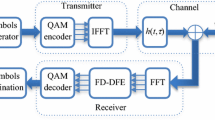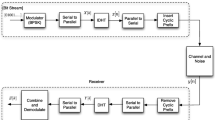Abstract
The generalized receiver (GR) based on a generalized approach to signal processing (GASP) in noise is investigated in a direct-sequence code-division multiple access (DS-CDMA) wireless communication system with frequency-selective channels. We consider four avenues: linear equalization with finite impulse response (FIR) beamforming filters; channel estimation and spatially correlation; optimal combining; and partial cancellation. We investigate the GR with simple linear equalization and FIR beamforming filters. Numerical results and simulation show that the GR with FIR beamforming filters surpasses in performance the optimum infinite impulse response beamforming filters with conventional receivers, and can closely approach the performance of GR with infinite impulse response beamforming filters. Channel estimation errors are taken into consideration so that DS-CDMA wireless communication system performance will not be degraded under practical channel estimation. GR takes an estimation error of a maximum likelihood (ML) multiple-input multiple-output (MIMO) channel estimation and GR spatially correlation into account in computation of minimum mean square error (MMSE) and log-likelihood ratio (LLR) of each coded bit. The symbol error rate (SER) performance of DS-CDMA employing GR with a quadrature sub-branch hybrid selection/maximal-ratio combining (HS/MRC) scheme for 1-D modulations in Rayleigh fading is obtained and compared with that of conventional HS/MRC receivers. Procedure of selecting a partial cancelation factor (PCF) for the first stage of a hard-decision partial parallel interference cancellation (PPIC) of the GR employed in DS-CDMA wireless communication system is proposed. A range of optimal PCFs is derived based on the Price’s theorem. Computer simulation results show superiority in bit error rate (BER) performance that is very close to that potentially achieved and surpasses the BER performance of the real PCF for DS-CDMA systems discussed in literature.
Similar content being viewed by others
References
K. Abed-Meraim, W. Qaiu, Y. Hua, Blind system identification. Proc. IEEE 85(8), 1310–1322 (1997)
M.-S. Alouini, A.J. Goldsmith, A unified approach for calculating error rates of linearly modulated signals over generalized fading channels. IEEE Trans. Commun. 47(9), 1324–1334 (1999)
M.-S. Alouini, M.K. Simon, Performance of coherent receivers with hybrid SC/MRC over Nakagami m-fading channels. IEEE Trans. Veh. Technol. 48(4), 1155–1164 (1999)
M.-S. Alouini, M.K. Simon, An MGF-based on performance analysis of generalized selection combining over Rayleigh fading channels. IEEE Trans. Commun. 48(3), 401–415 (2000)
A. Annamalai, C. Tellambura, A new approach to performance evaluation of generalized selection diversity receivers in wireless channels, in Proc. IEEE Vehicle Technology Conference, vol. 4 (2001), pp. 2309–2313
D.R. Brown III, C.R. Johnson Jr., SINR, power efficiency, and theoretical system capacity of parallel interference cancellation. J. Commun. Netw. 3(9), 228–237 (2001)
J. Choi, R. Heath, Interpolation based transmit beamforming for MIMO-OFDM with limited feedback. IEEE Trans. Signal Process. 53(11), 4125–4135 (2005)
J.M. Cioffi, G.P. Dudevoir, M.V. Eyuboglu, G.D. Forney Jr., MMSE decision-feedback equalizers and coding—part I: equalization results. IEEE Trans. Commun. 43(10), 2582–2594 (1995)
M.V. Clark, L.J. Greenstein, W.K. Kennedy, M. Shafi, Optimum linear diversity receivers for mobile communications. IEEE Trans. Veh. Technol. 43(2), 47–56 (1994)
J.W. Craig, A new, simple and exact result for calculating the probability of error for two-dimensional signal constellations, in Proc. IEEE International Conference on Military Communications, Milcom’91 (1991), pp. 571–575
P. Dighe, R. Mallik, S. Jamuar, Analysis of transmit-receive diversity in Rayleigh fading. IEEE Trans. Commun. 51(4), 694–703 (2003)
D. Divsalar, M.K. Simon, D. Raphaeli, Improved parallel interference cancellation for CDMA. IEEE Trans. Commun. 46(2), 258–268 (1998)
ETSI EN302 307 V1.1.1 (2004–2006), Digital video broadcasting (DVB); Second generation framing structure, channel coding and modulation systems for broadcasting, interactive services, news gathering and other broad-band satellite applications
W. Gerstacker, R. Schober, Equalization concepts for EDGE. IEEE Trans. Wirel. Commun. 1(1), 190–199 (2002)
M. Ghotobi, M.R. Soleymani, Multiuser detection of DS-CDMA signals using partial parallel interference cancellation in satellite communications. IEEE J. Sel. Areas Commun. 22(4), 584–593 (2004)
GSM recommendation 05.05: Propagation conditions, Version 5.3.0, release 1996
D. Guo, Linear parallel interference cancellation in CDMA. M. Eng. thesis, Nat. Univ. Singapore, 1998
Y.-T. Hsieh, W.-R. Wu, Optimal two-stage decoupled partial PIC receivers for multiuser detection. IEEE Trans. Wirel. Commun. 4(1), 112–127 (2005)
G. Jongren, M. Skoglund, B. Ottersten, Combining beamforming and orthogonal space-time block coding. IEEE Trans. Inf. Theory 48(3), 611–627 (2002)
S.M. Kay, Fundamentals of Statistical Signal Processing: Estimation Theory (Prentice-Hall, Englewood Cliffs, 1993)
J.H. Kim, J.-H. Kim, V. Tuzlukov, W.-S. Yoon, Y.D. Kim, FFH and MCFH spread spectrum wireless sensor network systems based on the generalized approach to signal processing. WSEAS Trans. Comput. 3(6), 1794–1801 (2004)
J.H. Kim, V. Tuzlukov, W.S. Yoon, Y.D. Kim, Generalized detector under nonorthogonal multipulse modulation in remote sensing systems. WSEAS Trans. Signal Process. 2(1), 203–208 (2005)
J.H. Kim, V. Tuzlukov, W.S. Yoon, Y.D. Kim, Macrodiversity in wireless sensor networks based on the generalized approach to signal processing. WSEAS Trans. Commun. 4(8), 648–653 (2005)
J.H. Kim, V. Tuzlukov, W.S. Yoon, Y.D. Kim, Performance analysis under multiple antennas in wireless sensor networks based on the generalized approach to signal processing. WSEAS Trans. Commun. 4(7), 391–395 (2005)
N. Kong, L.B. Milstein, Average SNR of a generalized diversity selection combining scheme. IEEE Commun. Lett. 3(3), 57–59 (1999)
K. Lee, J. Chun, Symbol detection in V-BLAST architectures under channel estimation error. IEEE Trans. Wirel. Commun. 6(2), 593–597 (2007)
H. Lee, I. Lee, New approach for error compensation in coded V-BLAST OFDM systems. IEEE Trans. Commun. 55(2), 345–355 (2007)
H. Lee, B. Lee, I. Lee, Iterative detection and decoding with an improved V-BLAST for MIMO-OFDM systems. IEEE J. Sel. Areas Commun. 24(3), 504–513 (2006)
J.C. Liberti Jr., T.S. Rappaport, Smart Antennas for Wireless Communications: IS-95 and Third Generation CDMA Applications (Prentice Hall, Upper Saddle River, 1999)
D. Love, R. Heath, T. Strohmer, Grassmannian beamforming for multiple-input multiple-output wireless systems. IEEE Trans. Inf. Theory 49(10), 2735–2747 (2003)
Lucent, Nokia, Simens, Ericsson, A standard set of MIMO radio propagation channels, 3GPP TSGR323 R1-01-1179
R.K. Malik, M.Z. Win, Analysis of hybrid selection/maximal-ratio combining in correlated Nakagami fading. IEEE Trans. Commun. 50(8), 1372–1383 (2002)
T.L. Marzetta, BLAST training: estimating channel characteristics for high-capacity space-time wireless, in Proc. 37th Annual Allerton Conference on Communications, Control, and Computing (1999), pp. 958–966
U. Mengali, A.N.D. Andrea, Synchronization Techniques for Digital Receivers (Plenum, New York, 1997)
T.K. Moon, W.C. Stirling, Mathematical Methods and Algorithms for Signal Processing (Prentice Hall, New York, 2000)
R.K. Morrow Jr., J.S. Lehnert, Bit-to-bit error dependence in slotted DS/SSMA packer systems with random signature sequences. IEEE Trans. Commun. 37(10), 1052–1061 (1989)
K. Mukkavilli, A. Sabharwal, E. Erkip, B. Aazhang, Beamforming with finite rate feedback in multiple antenna systems. IEEE Trans. Inf. Theory 49(10), 2562–2579 (2003)
D.P. Palomar, M.A. Lagunas, Joint transmit-receive space-time equalization in spatially correlated MIMO channels: a beamforming approach. IEEE J. Sel. Areas Commun. 21, 730–743 (2003)
A. Papoulis, S.U. Pillai, Probability, Random Variables and Stochastic Processes, 4th edn. (McGraw-Hill, New York, 2002)
J.G. Proakis, Digital Communications, 4th edn. (McGraw-Hill, New York, 2001)
P.G. Renucci, B.D. Woerner, Optimization of soft interference cancellation for DS-CDMA. Electron. Lett. 34(4), 731–733 (1998)
G. Taricco, E. Biglieri, Space-time decoding with imperfect channel estimation. IEEE Trans. Wirel. Commun. 4(4), 1874–1888 (2005)
L. Tong, S. Perreau, Multichannel blind identification: from subspace to maximal likelihood methods. Proc. IEEE 86(10), 1951–1968 (1998)
J.K. Tugnait, L. Tong, Z. Ding, Single user channel estimation and equalization. IEEE Signal Process. Mag. 17(3), 17–28 (2000)
V. Tuzlukov, Signal Processing in Noise: A New Methodology (IEC, Minsk, 1998)
V. Tuzlukov, A new approach to signal detection theory. Digit. Signal Process., Rev. J. 8(3), 166–184 (1998)
V. Tuzlukov, Signal Detection Theory (Springer, New York, 2001)
V. Tuzlukov, Signal Processing Noise (CRC Press, Boca Raton, 2002)
V. Tuzlukov, Signal and Image Processing in Navigational Systems (CRC Press, Boca Raton, 2004)
V. Tuzlukov, Selection of partial cancellation factors in DS-CDMA systems employing the generalized detector, in Proc.12th WSEAS International Conference on Communications: New Aspects of Communications (2008), pp. 129–134
V. Tuzlukov, Multiuser generalized detector for uniformly quantized synchronous CDMA signals in wireless sensor networks with additive white Gaussian noise channels, in Proc. International Conference on Control, Automation, and Systems, ICCAS 2008 (2008), pp. 1526–1531
V. Tuzlukov, Multiuser generalized detector for uniformly quantized synchronous CDMA signals in AWGN Channels. Telecommun. Rev. 20(5), 836–848 (2010)
V. Tuzlukov, W.S. Yoon, Y.D. Kim, Adaptive beam-former generalized detector in wireless sensor networks, in Proc. The IASTED International Conference on Parallel and Distributed Computing and Networks, PDCN 2004 (2004), pp. 195–200
V. Tuzlukov, W.S. Yoon, Y.D. Kim, Wireless sensor networks based on the generalized approach to signal processing with fading channels and receive antenna array. WSEAS Trans. Circuits Syst. 10(3), 2149–2155 (2004)
V. Tuzlukov, W.S. Yoon, Y.D. Kim, MMSE multiuser generalized detector for nonorthogonal multipulse modulation in wireless sensor networks, in Proc. 9th World Multi-Conference on Systemics, Cybernetics and Informatics, WMSCI 2005 (2005)
J. Wang, S. Li, Capacity and performance of MIMO BICM system with soft-output MMSE soft interference cancellation, in Proc. CCNC 2008 (2008)
M.X. Win, J.H. Winters, Analysis of hybrid selection/maximal ratio combining in Rayleigh fading. IEEE Trans. Commun. 47(12), 1773–1776 (1999)
M.Z. Win, J.H. Winters, Virtual branch analysis of symbol error probability for hybrid selection/maximal-ratio combining in Rayleigh fading. IEEE Trans. Commun. 49(11), 1926–1934 (2001)
K.-M. Wu, C.-L. Wang, Soft-input soft-output partial parallel interference cancellation for DS-CDMA systems, in Proc. IEEE International Conference on Communications, ICC’01 (2001), pp. 1172–1176
G. Xue, J.F. Weng, T. Le-Ngoc, S. Tahar, An analytic model for performance evaluation of parallel interference cancellers in CDMA systems. IEEE Commun. Lett. 4(6), 184–186 (2000)
R.E. Ziemer, W.H. Tranter, Principles of Communications: Systems, Modulation, and Noise, 6th edn. (Wiley, New York, 2010)
Author information
Authors and Affiliations
Corresponding author
Rights and permissions
About this article
Cite this article
Tuzlukov, V. Signal Processing by Generalized Receiver in DS-CDMA Wireless Communication Systems with Frequency-Selective Channels. Circuits Syst Signal Process 30, 1197–1230 (2011). https://doi.org/10.1007/s00034-011-9273-1
Received:
Revised:
Published:
Issue Date:
DOI: https://doi.org/10.1007/s00034-011-9273-1




